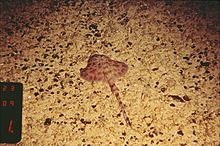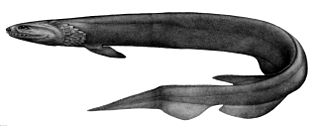
The frilled shark, also known as the lizard shark, is one of the two extant species of shark in the family Chlamydoselachidae. The frilled shark is considered a living fossil, because of its primitive, anguilliform (eel-like) physical traits, such as a dark-brown color, amphistyly, and a 2.0 m (6.6 ft)–long body, which has dorsal, pelvic, and anal fins located towards the tail. The common name, frilled shark, derives from the fringed appearance of the six pairs of gill slits at the shark's throat.

Raja, also known as raia, is a genus of skates in the family Rajidae containing 16 species. Formerly a wastebasket genus, many species historically categorized here have been moved to other genera in the family, such as Amblyraja, Beringraja, Dipturus, Leucoraja and Rostroraja. Raja are flat-bodied, cartilaginous fish with a rhombic shapes due to their large pectoral fins extending from or near from the snouts to the bases of their tails. Their sharp snouts are produced by a cranial projection of rostral cartilage. The mouth and gills are located on the underside of the body. They may be either solid-coloured or patterned, and most skates have spiny or thorn-like structures on the upper surface, while some species contain weak electrical organs within their tails. Mating typically occurs in the spring and the female lays numerous eggs per clutch which are encapsulated in leathery cases, commonly known as "mermaid’s purses". Species vary in size, ranging from about 40 to 140 cm (1.3–4.6 ft) in length. These bottom-dwellers are active during both day and night, and typically feed on molluscs, crustaceans and fish. Raja skates are found in the East Atlantic, also in the Mediterranean, and western Indian Ocean, ranging from relatively shallow water to a depth of 800 m (2,600 ft). Skates and related species have fossil records dating from the Upper Cretaceous period, thus this well-adapted species is quite ancient.

The barndoor skate is a species of marine cartilaginous fish in the skate family Rajidae of the order Rajiformes. It is native to the northwestern Atlantic Ocean, and is found from the Grand Banks of Newfoundland and the southern side of the Gulf of St. Lawrence south to North Carolina. The fish is one of the largest skates found in the North Atlantic Ocean, reaching lengths up to 1.5 m (5 ft). It is carnivorous, feeding on invertebrates and other fish found near the sea floor.

The spotback skate is a species of fish in the family Arhynchobatidae. It is found off the Atlantic coasts of Argentina, Brazil, and Uruguay where its natural habitat is over the continental shelf in the open sea. It is a large fish, growing to over a metre in length. It feeds mainly on other fish according to availability, with shrimps, octopuses and other invertebrates also being eaten. Reproduction takes place throughout most of the year, with the eggs being laid in capsules that adhere to the seabed. The spotback skate is the subject of a fishery and is thought to be overfished, resulting in Greenpeace adding the fish to its red list of fish to be avoided, and the International Union for Conservation of Nature listing it as an "endangered species".

The thornback ray, or thornback skate, is a species of ray fish in the family Rajidae.
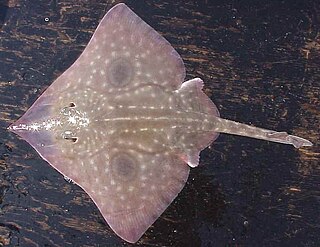
The big skate is the largest species of skate in the waters off North America. They are found along the Pacific Coast from Alaska to Baja California, typically from the intertidal zone to a depth of 120 m (390 ft), and feed on benthic invertebrates and small fishes. They are unusual among skates in that their egg cases may contain up to seven eggs each. This species is one of the most commercially important skates off California and is sold for food.

The smalleyed ray or smalleyed skate is a species of ray in the family Rajidae, the typical rays and skates, from the eastern Atlantic Ocean where it is found in tidal, coastal waters with sandy substrates.

Rostroraja is a genus of skate belonging to the family Rajidae, native to the Atlantic Ocean and East Pacific, including the Mediterranean, Caribbean, Gulf of Mexico and Gulf of California. The genus was considered monotypic in the past, but a number of species usually classified in Raja have been reassigned to this genus based on genetic analysis.

Fowlerichthys radiosus, the singlespot frogfish or big-eyed frogfish, is a species of marine ray-finned fish belonging to the family Antennariidae, the frogfishes. This fish is found in the Western Atlantic Ocean.

Fenestraja is a genus of eight species of skate in the family Gurgesiellidae. They are found in deeper waters of the western Atlantic and the Indian Ocean.

The clearnose skate is a species of cartilaginous fish in the family Rajidae. R. eglanteria is also known by other common names such as the brier skate and summer skate. Clearnose skates are easily identified by the translucent patches on either side of their snouts and their mottled dorsal surface. They are found along the Atlantic and Gulf coasts of the United States in shallow waters of the continental shelf.

The graytail skate, or gray tail skate, is a large species of skate in the family Arhynchobatidae, native to the south-western Atlantic Ocean and south-eastern Pacific Ocean. It is listed as endangered by the IUCN. It was caught as part of a commercial fishery around the Falkland Islands and is a bycatch in several other fisheries.
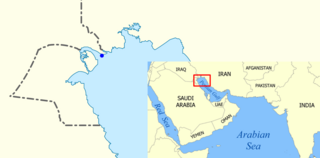
The pita skate is a medium-sized skate in the family Rajidae. The holotype and only known specimen was found in the northern Persian Gulf, in Iraqi waters. It was collected at a depth of less than 15 m (49 ft).
Dipturus teevani, commonly known as the prickly brown ray or Caribbean skate, is a species of cartilaginous fish in the family Rajidae. The prickly brown ray is medium in size compared to other skates, and is known from a patchy, deep-water distribution in the western Atlantic Ocean.
Synodus macrostigmus, commonly known as the largespot lizardfish, is a species of fish in the lizardfish family, Synodontidae, a basal ray-finned fish in the class Actinopterygii. It is native to the warm temperate western Atlantic Ocean and the Gulf of Mexico.
Ogcocephalus porrectus, the rosy-lipped batfish, is endemic to Cocos Island off the Pacific coast of Costa Rica. Though members of Ogcocephalidae occur in tropical, warm waters in both the Western Atlantic and Eastern Pacific. Rosy-lipped batfish generally reside in shallow to deep water benthic zones with a bathymetric range of 35 – 150 m. The syntypic series was collected at 120 m on a rocky bottom. What makes this fish distinctive are its rosy red lips, specialized pectoral fins used for "walking", and an illicium used for attracting prey.
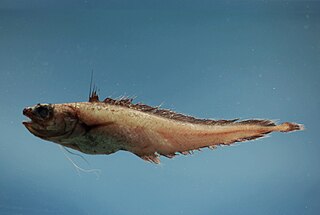
The short beard codling is a species of marine bony fish in the family Moridae. Native to the western Atlantic Ocean, it is found on the continental slope at depths between 50 and 1,620 m.

The Sydney skate is a species of skate of the family Rajidae native to waters off the east coast of Australia.

The blonde ray or blonde skate is a species of ray fish in the family Rajidae.

Rajella fyllae is a species of skate in the family Rajidae.
